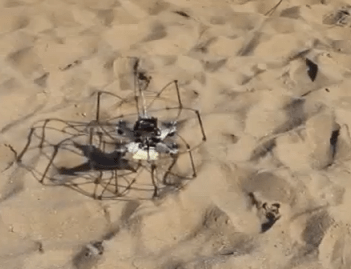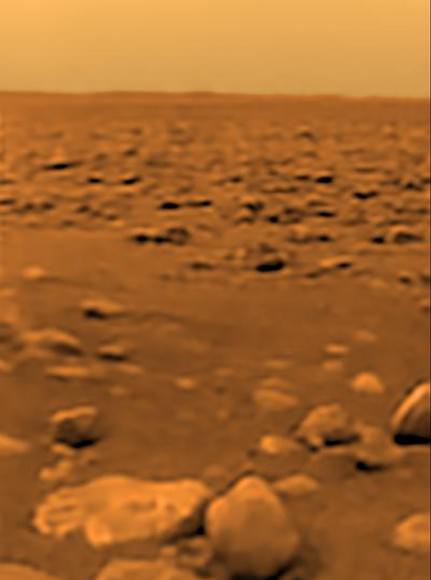The HyTAQ (Hybrid Terrestrial and Aerial Quadrotor) robot developed at Illinois Institute of Technology (IIT)
Ever since the Huygens probe landed on Titan back in January 2005, sending us our first tantalizing and oh-so-brief glimpses of the moon’s murky, pebbly surface, researchers have been dreaming up ways to explore further… after all, what’s more intriguing than a world in our own Solar System that’s basically a miniature version of an early Earth (even if it’s quite a few orders of magnitude chillier?)
Many concepts have been suggested as to the best way to explore Titan, from Mars-style rovers to boats that would sail its methane seas to powered gliders… and even hot-air balloons have been put on the table. Each of these have their own specific benefits, specially suited to the many environments that are found on Titan, but what if you could have two-in-one; what if you could, say, rove and fly?
That’s what this little robot can do.
Designed by Arash Kalantari and Matthew Spenko at the Robotics Lab at Illinois Institute of Technology, this rolling birdcage is actually a quadrotor flying craft that’s wrapped in a protective framework, allowing it to move freely along the ground and then take off when needed, maneuvering around obstacles easily.
A design like this, fitted with scientific instruments and given adequate power supply, might make a fantastic robotic explorer for Titan, where the atmosphere is thick and the terrain may range from rough and rocky to sandy and slushy. (And what safer way to ford a freezing-cold Titanic stream than fly over it?)
Also, the robot’s cage design may make it better suited to travel across the frozen crust of Titan’s flood plains, which have been found to have a consistency like damp sand with a layer of frozen snow on top. Where wheels could break through and get permanently stuck (a la Spirit) a rolling cage might remain on top. And if it does break through… well, fire up the engines and take off.
The robot (as it’s designed now) is also very energy-efficient, compared to quadrotors that only fly.
“During terrestrial locomotion, the robot only needs to overcome rolling resistance and consumes much less energy compared to the aerial mode,” the IIT website notes. “This solves one of the most vexing problems of quadrotors and rotorcraft in general — their short operation time. Experimental results show that the hybrid robot can travel a distance 4 times greater and operate almost 6 times longer than an aerial only system.”
Of course this is all just excited speculation at this point. No NASA or ESA contracts have been awarded to IIT to build the next Titan explorer, and who knows if the idea is on anyone else’s plate. But innovations like this, from schools and the private sector, are just the sorts of exciting things that set imaginations rolling (and flying!)
Color view of Titan’s surface, captured by the Huygens probe after landing in January 2005. (NASA/JPL/ESA/University of Arizona)
Video by RoboticsIIT



I’d love to see how they make it work in a muddy environment when it’ll weigh 1 ton, sync half a meter into the ground and have 10 instruments on board + a robotic arm
Especially given that in order to operate for any significant length of time it will need a RTG (or a similar uranium based device) that produces quite a bit of heat. In an airship that’s fine, but if you’re on a frozen hydrocarbon surface the waste heat coming off of it will melt the ground and cause it to sink shortly after stopping for the first time.
Titan represents quite an engineering problem:).
Definitely an engineering challenge. But those can be overcome. Perhaps these could be deployable smaller rovers from a larger ship, even.
Deploy 1K grid sensor array at these co-ordinates …..
How about using these to Investigate in detail… Phoenix, Viking lander(s), Spirit, Sojourer Opportunity landing sites and tracks? It might be good to know if/how traces have been altered over time? Any icy dust drifts or dune movement anywhere? What do closeup images of the previous track(s) say about soil cohesion?
Then again.. you could have a group of them join together to form a BIG dust buster! You trying to taka look at what’s under all that dust mister?
Remember those trenches Spirit’s wheel dug? Let’s use these machines to blow off those surfaces and see exactly how big that mineral bearing unit is? Visit Spirit and Oppy and blow off the lens and solar cells?
Actually… I’d like to have one of those suckers! Whattah hoot! Raccoon or squirrel patrol anybody?
I would need to look it up to get a precise figure, but the surface gravity on Titan I think is about 10% that of Earth. So any object is not going to weight much. Also the atmospheric pressure is several times that on Earth. Consequently the lifting ability would be enhanced.
LC
the gravity on Titan is low so inertial mass would be the only factor to worry over.
this concept could be easily expanded to include a rumba-type charging station.
Flying, rolling, floating robot would be nice especially for losing it; like Minerva !
Before defining the equipment, establishing the priorities of the search should come before… I prefer a stationary laboratory, can be survived for some time.
All I want to know is where do I get one????! Oh yeah, and what happens to this cute little light craft in high winds. I don’t think just sitting on the ground is going to help much. Does anyone know what kind of winds there are on Titan? I think the problem of high winds, if there are any, also applies to airships.
With a low gravity and thick atmosphere, a balloon system to float around using a type of sailing rudder system for navigation would be exellent. It could be heavy, manuverable, and have low energy consumption.